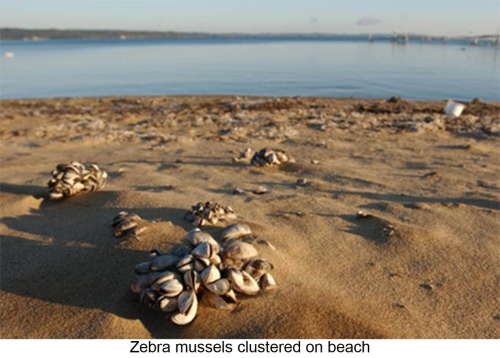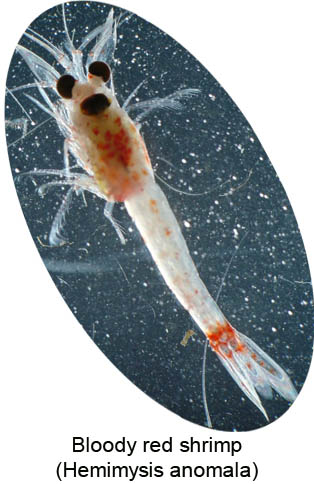Aquatic invasive species in Michigan
Aquatic Invasive Species (AIS) threaten the health and vitality of Michigan’s Great Lakes and inland waters. AIS compete with native species for food and habitat, disrupt aquatic food webs, impact water quality and cost the state millions.
The Great Lakes Environmental Research Laboratory reports that as of 2007, there were more than 180 aquatic invasive species with reproducing pop ulations in the Great Lakes. These include fish, invertebrates, microscopic organisms, and aquatic plants.1 Among the species considered invasive in Michigan waters are zebra mussels, quagga mussels, sea lamprey, round goby, Eurasian ruffe, spiny waterflea and fish hook waterflea.
ulations in the Great Lakes. These include fish, invertebrates, microscopic organisms, and aquatic plants.1 Among the species considered invasive in Michigan waters are zebra mussels, quagga mussels, sea lamprey, round goby, Eurasian ruffe, spiny waterflea and fish hook waterflea.
Of these invaders, zebra mussels best illustrate the multiple impacts of a single species on an ecosystem. Since their arrival in Lake St. Clair in the late 1980s, zebra mussels rapidly spread to all the Great Lakes and now inhabit more than 225 of Michigan’s inland lakes. Zebra mussels create a costly problem for waterfront municipalities and businesses by attaching to hard surfaces and clogging water intake pipes. Ecologically, the small mollusk has been linked to complex food web disruptions in the Great Lakes and blooms of microsystis, a blue-green algae with toxic properties. Scientists suspect zebra mussels may even be linked to a re-emerging dead zone in Lake Erie.
A recent invader is the crustacean known as bloody red shrimp (Hemimysis anomala), first found in late 2006 in the channel between Lake Michigan and Muskegon Lake. The presence of viral hemorrhagic septicemia (VHS), a fish disease, has already caused several large-scale fish kills in the Great Lakes.2 Still other species, such as Asian carp, would potentially have a devastating impact on Michigan’s sport fishery if they make their way into the Great Lakes. 
Invasive aquatic plants also pose a threat to Michigan’s coastal areas, wetlands and inland lakes. Fast-growing shoreline plants such as purple loosestrife (Lythrum salicaria) and common reed (Phragmites australis) spread quickly and crowd out existing vegetation, causing a decline in the diversity of native plants. As habitat quality deteriorates, native fish and wildlife must look elsewhere for food and shelter. In open waters, the aquatic plant Eurasian watermilfoil (Myriophyllum spicatum) forms thick mats of vegetation at the water’s surface that block sunlight for native plants and also hinder boating and swimming.
It is estimated that a new aquatic invasive species arrives in the Great Lakes at a rate of one every eight months.3 While some invasive species are the result of unwanted fish and aquatic plants released from home aquariums, many others are inadvertently transported via human travel and commerce. Approximately 30% of new species are unintentionally brought to the Great Lakes in the ballast tanks of ocean going freighters.4 The total economic losses in the Great Lakes basin due to aquatic invasive species were estimated at $5 billion per year in 2005.4
Once established in the Great Lakes or inland lakes, aquatic invasive species are nearly impossible to eradicate. To curb the spread of AIS, in 2005 Michigan established several invasive species laws under which lists of restricted and prohibited species, rules of possession and penalties for intentional introduction and releases were developed. A permit program was also developed in conjunction with the new invasive species laws.
More recently, Michigan enacted a ballast water law (2007) that requires ocean-going vessels engaging in port operations in Michigan to either keep their ballast on board or use a state-approved method to treat any aquatic life before water is released. Each vessel must also carry an annual ballast permit from the Michigan Department of Environmental Quality.
MSU Extension offers a variety of outreach and educational opportunities to learn about the many aquatic invasive species in the Great Lakes, and how to prevent the introduction of new species, control the spread of established invasive species and mitigate their ecological and socio-economic impacts. To learn more about aquatic invasive species, visit the Michigan Sea Grant website.
Sources
1 Great Lakes Environmental Research Laboratory
2 Michigan Department of Natural Resources
3 Great Lakes Regional Collaboration
4 Environmental Protection Agency, Great Lakes National Program Office



 Print
Print Email
Email


